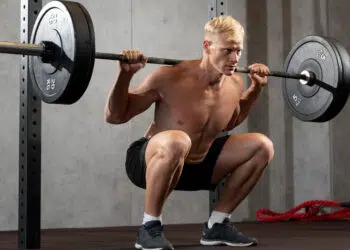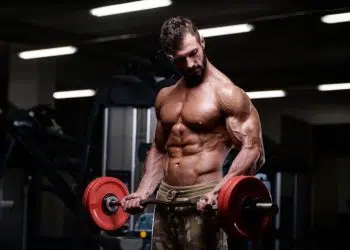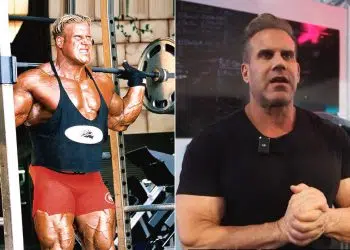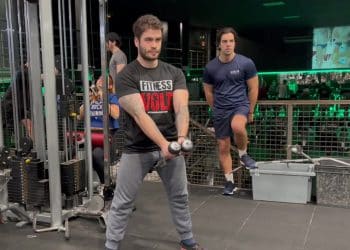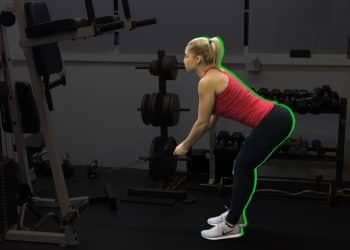When it comes to building lower body muscle size and strength, squats are hard to beat. They truly deserve their title of the king of leg exercises. In fact, if you only ever did squats for your legs, your quads, glutes, and hamstrings would probably be impressively big and strong.
But, like any exercise, even squats can lose their shine and will become less productive if you do them too often or for too long.
The good news is there are plenty of similarly effective leg exercises you can use to build the lower body of your dreams. Great options include Bulgarian split squats, leg presses, and trap bar deadlifts.
And now there is another exercise you can add to your leg training routine – the Kang squat. This exercise is highly unusual and tricky to master. Still, it could help you unlock new levels of strength and muscle growth.
We reveal why and how to do Kang squats and provide you with some similarly effective alternatives to try.
Kang Squat Muscles Worked
Kang squats, named after renowned Korean weightlifting coach Shin-Ho Kang, combine back squats with good mornings to provide a complete lower body workout. They’re a compound exercise, meaning they involve movement at two or more joints and train many muscles simultaneously.
Level Up Your Fitness: Join our 💪 strong community in Fitness Volt Newsletter. Get daily inspiration, expert-backed workouts, nutrition tips, the latest in strength sports, and the support you need to reach your goals. Subscribe for free!
The main muscles trained by Kang squats are:
- Quadriceps – located on the front of your thighs, the quadriceps extend your knees. There are four quadriceps: the rectus femoris, vastus lateralis, vastus medialis, and vastus intermedius.
- Hamstrings – most squat variations involve relatively little hamstring engagement. Kang squats are different! Located on the back of your thighs, the hamstrings extend your hips. The three hamstring muscles are the biceps femoris, semimembranosus and semitendinosus.
- Gluteus maximus – known as the glutes for short, this is the largest and most powerful muscle in the human body. The main function of the glutes is the extension of the hip.
- Abductors – located on the outside of your hips and thighs, the abductors lift your legs out and away from the midline of your body. The abductor muscles are gluteus minimus, gluteus medius, and tensor fascia latae. During Kang squats, these muscles are responsible for stabilizing your hips and knees and preventing them from falling inward.
- Adductors – located on the inside of your thighs, the adductors draw your legs toward the midline of your body. During Kang squats, their main job is stopping your knees from falling outward. The three adductor muscles are longus, brevis, and magnus, meaning longest, shortest, and biggest.
- Erector spinae – Kang squats involve a lot of torso flexion. In other words, you lean forward as you perform them. This puts tension on your lower back muscles, which are known as your erector spinae. During Kang squats, these muscles work to prevent your back from rounding.
- Core – core is the collective term for the muscles of your midsection, including the rectus abdominis, obliques, and transverse abdominis. Together, these muscles contract inward to create intra-abdominal pressure, which supports your lumbar spine. In many ways, the core acts a lot like a weightlifting belt.
How to Do Kang Squat
Get more from Kang squats while keeping your risk of injury to a minimum by following these guidelines:
- Rack and hold a barbell across your upper back.
- Stand with your feet about shoulder-width apart, toes turned slightly outward. Brace your core and lift your chest.
- Bend your knees slightly, push your hips to the rear, and hinge forward to perform a good morning. Lean over as far as you can without rounding your lower back.
- Next, bend your knees, bring your hips forward and down, and descend into a squat. Keep your knees apart by contracting your hip abductors.
- Drive your feet into the floor and lift your hips up. Keep your upper body parallel to the floor.
- Finish your rep by pushing your hips forward and standing up.
- That’s one rep – keep going!
Tips:
- Make sure the bar rests on your upper traps and not your neck. Hold the bar in place, as you don’t want it to move during your set.
- Experiment with your stance width. Some people find this exercise more comfortable with a wider or narrow than shoulder-width stance.
- Do Kang squats in a power rack for safety.
- This exercise works best when done for low to moderate weights, i.e., 4-8.
- Use a slow, controlled tempo for all your reps and sets.
- Stop your set if your lower back begins to round.
Kang Squat Benefits
Not sure if Kang squats deserve a place in your workouts? Consider these benefits and then decide!
A complete leg exercise
Squats are a knee-dominant exercise that mostly works your quads. Good mornings are a hip-dominant exercise that mostly works your glutes and hamstrings. Kang squats combine both these movements to deliver an all-in-one total leg exercise.
Time-efficiency
Short on time, but still want to train your legs? Kang squats work all your major lower body muscles in one time-efficient exercise. Friends don’t let friends skip leg day. And now, with Kang squats, you have one less excuse for not training your legs.
Workout variety
Bored of doing the same old squats and leg presses? Breathe new life into your workouts with Kang squats. Adding new exercises to your workouts is a great way to make your workouts productive and interesting again.
Teaches you how to “rescue” your squat
It happens to most powerlifters and strongman competitors at some point: you start to fall forward during a squat. Kang squats teach you how to rescue your squat so you don’t end up face-planting or missing your lift.
Improved hip mobility
Kang squats will test and improve your hip and hamstring flexibility and mobility. Done with light weights, this is a great dynamic warm-up before squats, deadlifts, Romanian deadlifts, or good mornings.
Drawbacks
While Kang squats are a mostly beneficial exercise, there are also a few drawbacks to consider:
A tricky exercise to learn and master
Before you attempt Kang squats, you must be able to squat and good morning like a pro. Even then, combining these two exercises into a single flowing movement isn’t easy. This is not an exercise for beginners, and more experienced lifters should start light and master the technique before adding weight.
Increased risk of back injury
Leaning forward with a barbell on your back creates a long lever that puts a lot of stress on your lower back. When your spine is neutral, i.e., slightly arched, most of this weight is supported by your muscles. But, if you round your lower back, more of the stress ends up on your intervertebral ligaments and discs.
Either way, there is a risk of back injury during Kang squats, and it’s probably best avoided by anyone with a history of back pain.
The strength disparity between movements
Most lifters will be able to squat much more weight than they can use for good mornings. As such, you may find that this exercise provides your lower back and hamstrings with a great workout but goes a little too easy on your quads.
In this case, you may get better results by doing squats and good mornings separately so you can use appropriate weights for both movements.
5 Kang Squat Variations and Alternatives
Kang squats are a highly effective lower body exercise, but that doesn’t mean you need to do them all the time. There are several variations and alternatives you can use to keep your workouts productive and interesting:
1. Kettlebell Kang Squat
While Kang squats are typically done with a barbell, that doesn’t mean you always have to do them that way. So, grab a kettlebell for Kang squats; they feel very different done this way, and many lifters find them more comfortable.
Steps:
- Rest a kettlebell on your upper traps and hold it in place.
- Stand with your feet about shoulder-width apart, toes turned slightly outward. Brace your core and lift your chest.
- Bend your knees slightly, push your hips to the rear, and hinge forward to perform a good morning. Lean forward as far as you can without rounding your lower back.
- Next, bend your knees, bring your hips forward and down, and descend into a squat. Keep your knees apart by contracting your hip abductors.
- Drive your feet into the floor and lift your hips up. Keep your upper body parallel to the floor.
- Finish your rep by pushing your hips forward and standing up.
Muscles targeted:
- Primary: Hamstrings, quadriceps, gluteus maximus.
- Secondary: Erector spinae, core.
Benefits:
- A more accessible exercise for home trainees.
- Potentially more comfortable than the barbell variation.
- A valuable alternative to barbell King squats.
- It’s easier to dump the weight if you are unable to complete a rep.
Tips:
- Hold the kettlebell by its vertical horns for a more secure grip.
- Keep your chest up and your lower back slightly arched throughout.
2. Good Morning / Back Squat Superset
If you find it hard to combine good mornings and squats into one movement, you can just do these two exercises as a back-to-back superset. Simply do your good mornings, e.g., 6-10 reps, and then transition into a set of squats. This is far less demanding than Kang squats but works the same muscles.
Steps:
- Rack and hold your barbell across your upper back. Stand with your feet about shoulder-width apart, knees slightly bent, and core braced.
- Hinge forward from the hips and lean over as far as you can without rounding your lower back.
- Drive your hips forward and stand up.
- Repeat for the required number of reps.
- Next, bend your knees and squat down until your thighs are roughly parallel to the floor.
- Stand back up and repeat for the desired number of reps.
Muscles targeted:
- Primary: Hamstrings, quadriceps, gluteus maximus.
- Secondary: Erector spinae, core.
Benefits:
- Technically easier to perform than Kang squats.
- A more accessible way to train for beginners and early intermediates.
- A time-efficient way to train your entire lower body.
Tips:
- You can also do this exercise by alternating between good mornings and back squats, like this:
3. Good Morning / Goblet Squat Combo
No barbell? No problem! You can get a great lower body workout using just a dumbbell. In fact, this dumbbell variation may be better for a lot of lifters because you don’t need a squat rack and can just drop your weight if you are unable to complete a rep.
Steps:
- Hold a dumbbell or kettlebell in front of your chest. Brace your core and pull your shoulders down and back. Stand with your feet about shoulder-width apart, knees slightly bent.
- Push your hips back and lean forward as far as you can without rounding your lower back.
- Stand up straight.
- Next, bend your knees and descend into a deep squat. Take care not to round your lower back.
- Stand back up.
- Alternate between these two movements for the desired number of reps.
Muscles targeted:
- Primary: Hamstrings, quadriceps, gluteus maximus.
- Secondary: Erector spinae, core.
Benefits:
- No special equipment is required – just a dumbbell or kettlebell.
- A good exercise for mastering the hip hinge and squat movements.
- A very safe exercise if you want to train close to failure.
- An excellent exercise for improving posture and increasing upper back strength.
Tips:
- Experiment with a narrower or wider-than-shoulder-width stance to see which works best for you.
- You can also perform this variation with a barbell on your back or in the crooks of your arms, i.e., a Zercher good morning/squat combo.
- This exercise works best with light to moderate weights and medium to high reps.
4. Power Clean and Front Squat Combo
Most barbell exercises are performed with a slow, controlled tempo. While that’s good for building strength and muscle mass, it’s less useful for training speed and power. This two-exercise combo works the same muscles as the Kang squat, but the movements are more athletic.
Level Up Your Fitness: Join our 💪 strong community in Fitness Volt Newsletter. Get daily inspiration, expert-backed workouts, nutrition tips, the latest in strength sports, and the support you need to reach your goals. Subscribe for free!
Steps:
- Place your barbell on the floor. It should be about mid-shin height or about nine inches above the ground. Stand with your feet between shoulder and hip-width apart, toes under the bar.
- Squat down and hold the bar with an overhand grip, hands about shoulder-width apart.
- Straighten your arms, lift your chest, drop your hips, and brace your abs.
- Drive your feet into the floor and stand up, taking care not to round your lower back.
- As the bar passes your knees, pull with your arms and draw the bar up the front of your body.
- Drive your elbows forward and catch the barbell across your anterior deltoids.
- Next, bend your legs and descend into a deep front squat. Keep your torso upright and your elbows/upper arms up.
- Stand up, roll the bar off your shoulders, and lower it back to the floor.
- Reset your grip and core, and repeat.
Muscles targeted:
- Primary: Hamstrings, gluteus maximus, quadriceps, trapezius.
- Secondary: Deltoids, core, biceps.
Benefits:
- A time-efficient way to train your entire lower body and much of your upper body.
- An excellent power and strength exercise for athletes.
- Develops agility and mobility as well as muscle power and strength.
Tips:
- Focus more on bar speed than the amount of weight. Slow, grinding reps are less effective for building power.
- Start/finish each rep at just below knee height – the hang position – for variety and to increase upper back engagement.
- Wear weightlifting shoes to raise your heels and achieve a deeper front squat.
5. Romanian Deadlift and Bent-over Row Combo
The Kang squat combines two exercises to work multiple muscle groups simultaneously. This is a very time-efficient and functional way to train. There are lots of exercising pairings that work almost as well as Kang squats, including this posterior-chain bustin’ Romanian deadlift and bent-over row combo.
Steps:
- Hold a barbell with an overhand, wider than shoulder-width grip. Stand with your feet about hip-distance apart, knees slightly bent. Brace your core.
- Hinge forward from your hips and lower the bar down the front of your legs.
- Row the bar up and into your midsection, and then lower it again.
- Stand up straight and repeat.
Muscles targeted:
- Primary: Gluteus maximus, hamstrings, erector spinae, latissimus dorsi.
- Secondary: Posterior deltoids, trapezius, biceps.
Benefits:
- A time-efficient way to train your entire posterior chain.
- Builds isotonic and isometric hip strength at the same time.
- An excellent functional exercise for athletes from all sports.
Tips:
- Don’t go too heavy too soon; this is a very challenging exercise.
- Experiment with an underhand and overhand grip to see which one you prefer.
- You can also do this exercise with dumbbells, a trap bar, or a multi-grip football bar.
Kang Squat Leg Workout
The Kang squat is a great exercise, but you’ll get more from it if you incorporate them into a balanced lower-body workout. Here’s a Kang squat-based leg workout to try. Do it 1-2 times per week to build strong, muscular quads, hamstrings, and glutes.
But before you begin, make sure you spend a few minutes warming up to prepare your muscles and joints for what you are about to do. Start with 5-10 minutes of cardio followed by dynamic mobility and flexibility exercises for your legs and lower back. Finally, finish with a couple of light sets of Kang squats to practice your technique.
| # | Exercise | Sets | Reps | Recovery |
| 1 | Kang squat | 5* | 6-8 | 3 minutes |
| 2a | Leg extensions | 3** | 10-12 | 90 seconds |
| 2b | Leg curls | |||
| 3 | Bulgarian split squat | 3 | 10-12 per leg | 90 seconds |
| 4 | Leg press | 3 | 12-15 | 60 seconds |
| 5 | Standing calf raise | 3 | 15-20 | 60 seconds |
Read more about warming up for strength training here.
* Increase the weight set by set, i.e. pyramid training.
For example:
- 8 reps 135lbs
- 7 reps 155lbs
- 6 reps 175lbs
- 6 reps 180lbs
- 6 reps 185lbs
** Perform exercises 2a and 2b as a superset. So, do one set of leg extensions and then, without resting, a set of leg curls. Catch your breath for 90 seconds, and then repeat the pairing twice more to make three supersets.
Kang Squat FAQs
Got a question about Kang squats? We’ve got the answers to the most common queries and concerns about this challenging exercise!
1. How often can I do Kang squats?
Kang squats are pretty demanding, so you should probably limit their use to once or twice a week. If you choose to do them twice, do one heavy workout and one lighter workout to avoid overtraining your lower back.
2. How many reps should I do for Kang squats?
Kang squats are a very technical exercise. As such, a lot can go wrong when you are doing them. Because of this, you should keep your sets short, so you can focus on training with perfect technique. For example, a range of 4-8 reps is best for Kang squats, but you can do as many as 10-12 reps with a light weight and for warm-ups.
3. How much weight should I use for Kang squats?
Unfortunately, this is one of those questions that’s impossible to answer. We don’t know how strong you are, so we can’t tell you how much weight you should lift.
The best way to determine how much weight to use for Kang squats is to start with an empty bar and do sets of 6-8 with gradually heavier weights until you reach a load that feels challenging. This is the weight you should use for your next workout. Then, as you get stronger, add a little more weight to keep challenging your muscles.
That all said, Kang squats are a very demanding exercise, so don’t try to go too heavy too soon. Doing so could lead to serious injuries.
4. Can I train Kang squats to failure?
Just because you CAN do something doesn’t mean you should! Doing Kang squats to failure is a bad idea because, invariably, it’ll be your lower back that quits first. A rounded lower back is a weak lower back, and training Kang squats to failure is a recipe for injury.
So, leave a couple of reps in the tank at the end of each set, and stop before your form starts to deteriorate.
5. My lower back rounds when I do Kang squats. How can I fix this?
Here are the most common reasons and the fixes for lower back rounding during Kang squats:
- Tight hamstrings – stretch them!
- Weak core – work on your core strength.
- Weak spinal erectors – reduce the weight and strengthen your lower back.
- Leaning too far forward – reduce your range of motion.
- Weight is too heavy – use less weight or do a few less reps per set.
- Poor form – use less weight and practice the movement. Use an empty barbell or even just a broomstick to master the movement before adding weight.
6. Will Kang squats give me a bigger butt?
Kang squats are a very glute-centric exercise. Good mornings and back squats engage the glutes, and Kang squats involve both of these movements. If you want a bigger, more muscular butt, adding Kang squats to your lower body workouts could help.
7. Do I have to do Kang squats?
While Kang squats are an effective exercise, they are not compulsory. In fact, for some people, they may be too technically demanding and doing squats and good mornings separately could be better.
Try them, but if you don’t like them, you can do something else, such as the variations and alternatives outlined above.
Wrapping Up
You probably won’t see many people doing Kang squats, and that’s hardly surprising. It’s a specialist exercise mostly used by Olympic weightlifters and a few powerlifters. However, don’t let this put you off – the Kang squat is a great way to train all your lower body muscles simultaneously.
Are Kang squats better than doing squats and good mornings separately? Maybe, but maybe not.
They’re certainly more time-efficient, but the natural strength disparity between squats and good mornings may mean you end up training your quads less than your posterior chain.
The best (or even the only) way to find out if Kang squats are a good exercise for you is to try them for yourself.
Interested in measuring your progress? Check out our strength standards for Good Morning, Bulgarian Split Squat, Goblet Squat, and more.


